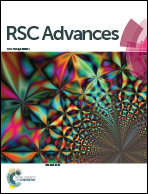Facile hydrothermal synthesis of flower-like Co-doped NiO hierarchical nanosheets as anode materials for lithium-ion batteries
Abstract
Co-doped NiO hierarchical nanosheets with a flower-like morphology were synthesized using a facile hydrothermal process and characterized systematically by X-ray diffraction, X-ray photoelectron spectroscopy, field-emission scanning electron microscopy, energy dispersive X-ray spectrometry and electrochemical measurements. The assembled Co-doped NiO electrode was found to deliver an initial discharge capacity of 1487.5 mA h g−1 and it retained a reversible capacity of up to 708 mA h g−1 after 50 cycles at a current density of 0.1C (1C = 718 mA h g−1). By contrast, a pristine NiO electrode tested under the same conditions delivered a reversible capacity of 128.7 mA h g−1 after 50 cycles. The doped electrode also exhibited a high Coulomb efficiency, excellent cycle stability and good rate capability when compared with an undoped electrode. This improved electrochemical performance is attributed primarily to the efficient substitution of Co2+ for Ni2+ in the metal oxide matrix, which enhanced the p-type conductivity of NiO by the generation of free holes in the valence band. Moreover, the novel nanosheet structure was also able to enlarge the electrode/electrolyte contact area and shorten the path length for lithium ion transport. It is reasonable to conclude that the reported superior lithium storage capacity Co-doped NiO hierarchical nanosheets can be a promising new anode material for high-performance lithium-ion batteries.


 Please wait while we load your content...
Please wait while we load your content...